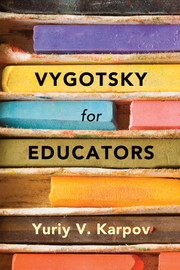Book contents
- Frontmatter
- Dedication
- Contents
- List of Figures
- Acknowledgments
- Introduction
- Part I Mediation from Birth through Adolescence
- 1 The Vygotskian Notion of Mediation as the Major Determinant of Children’s Learning and Development
- 2 First Year of Life
- 3 Second and Third Years
- 4 Three- to Six-Year-Olds
- 5 Mediation of Preschoolers’ Activities to Promote School Readiness
- 6 Learning at School: Children Not Only Learn; They Develop As Well
- 7 Understand Adolescents and Make a Difference!
- Part II School: What to Teach and How to Teach
- Notes
- Index
5 - Mediation of Preschoolers’ Activities to Promote School Readiness
Published online by Cambridge University Press: 05 June 2014
- Frontmatter
- Dedication
- Contents
- List of Figures
- Acknowledgments
- Introduction
- Part I Mediation from Birth through Adolescence
- 1 The Vygotskian Notion of Mediation as the Major Determinant of Children’s Learning and Development
- 2 First Year of Life
- 3 Second and Third Years
- 4 Three- to Six-Year-Olds
- 5 Mediation of Preschoolers’ Activities to Promote School Readiness
- 6 Learning at School: Children Not Only Learn; They Develop As Well
- 7 Understand Adolescents and Make a Difference!
- Part II School: What to Teach and How to Teach
- Notes
- Index
Summary
Although, as discussed in the previous chapter, the Vygotskians view sociodramatic play as the most important preschooler activity, preschoolers are engaged in other age-specific activities, such as constructive play with the use of building blocks, listening to and retelling fairy tales, playing with dollhouses, playing with water and sand, motor activities (such as running and jumping), and so forth. No doubt, these activities are fun and contribute somewhat to children’s cognitive, social, and motor development, especially if they are performed with adult involvement. The point is, however, that these age-specific activities can be substantially modified and enriched so that they will promote children’s development to a much greater extent and will specifically target the development of children’s school readiness. In this chapter, I describe several such activities designed by the Vygotskians for Pre-Kindergarten and Kindergarten children.
Architects, Builders, and Building Inspectors
This activity begins with the teacher suggesting to children that they become architects; they will be drawing houses and castles, and other children will be using their drawings to build these houses and castles. To be sure, the children become very enthusiastic about this suggestion. But, to become an architect, one should learn first to draw what a house or castle looks like from different sides.
- Type
- Chapter
- Information
- Vygotsky for Educators , pp. 75 - 93Publisher: Cambridge University PressPrint publication year: 2014



